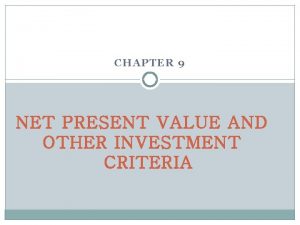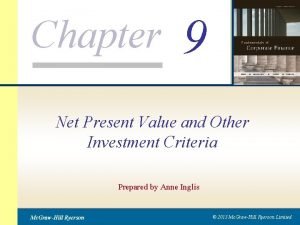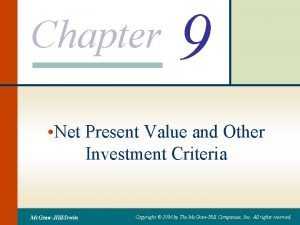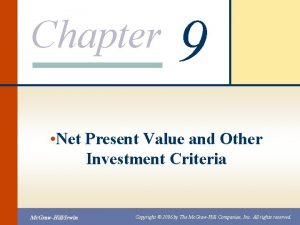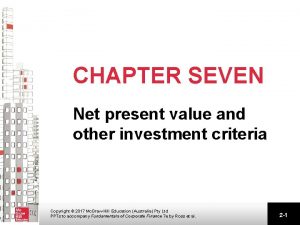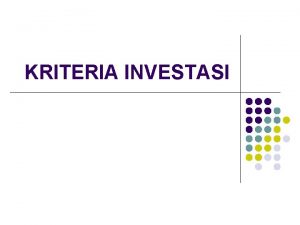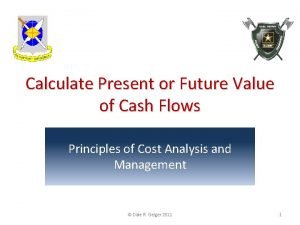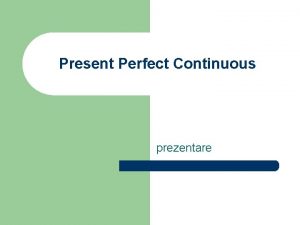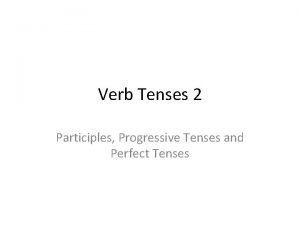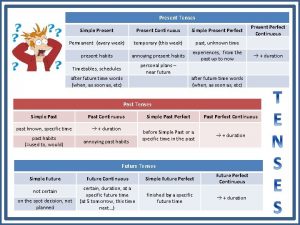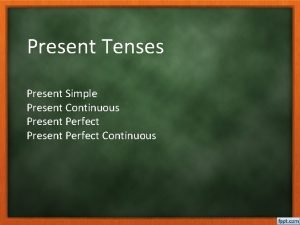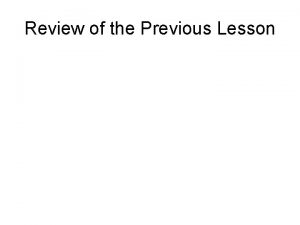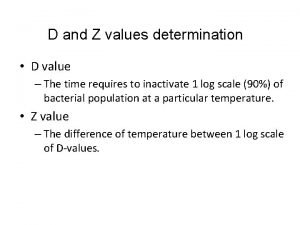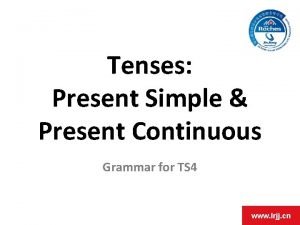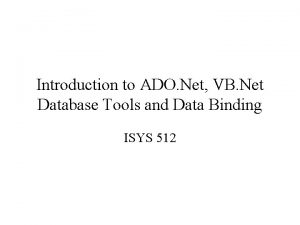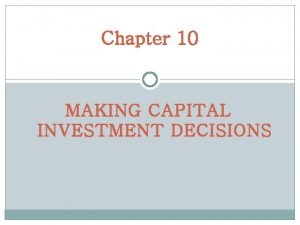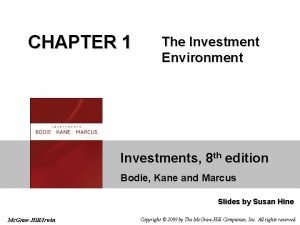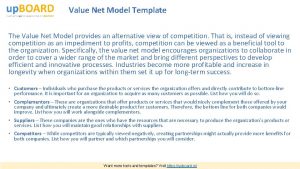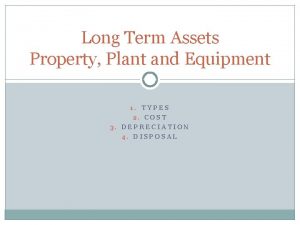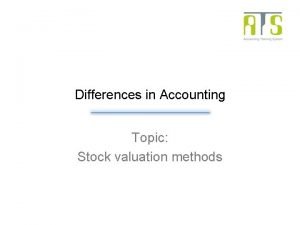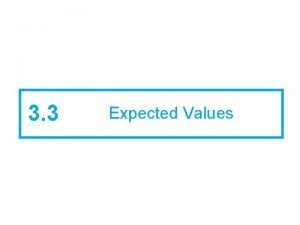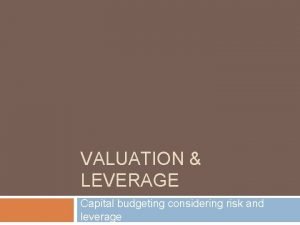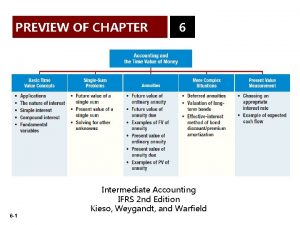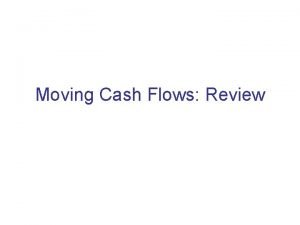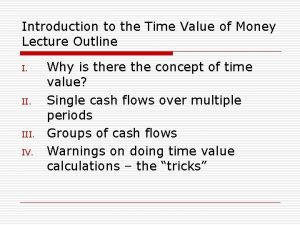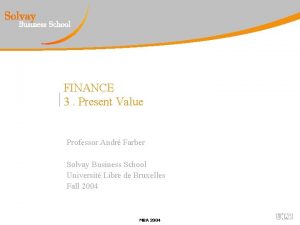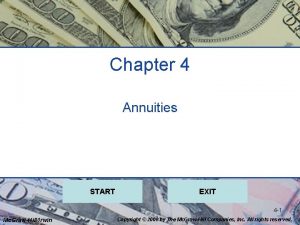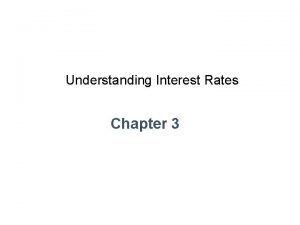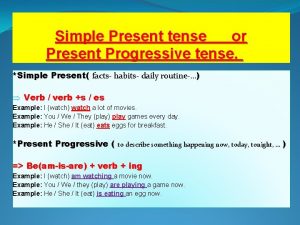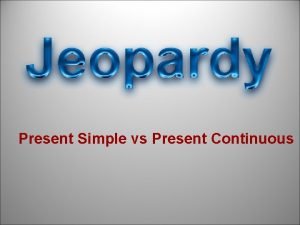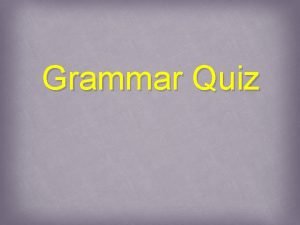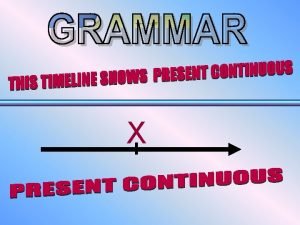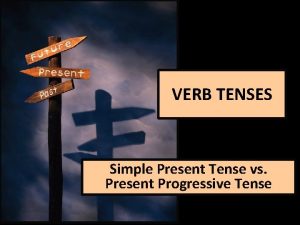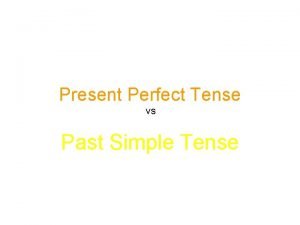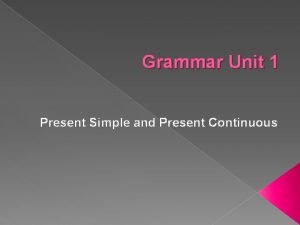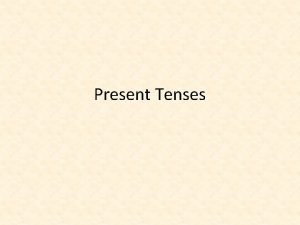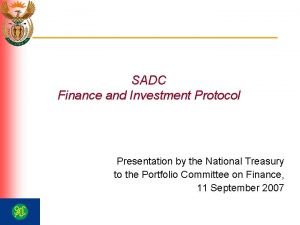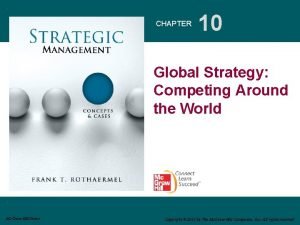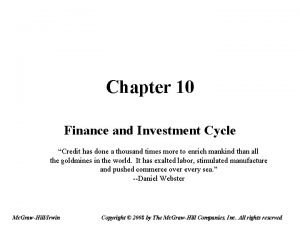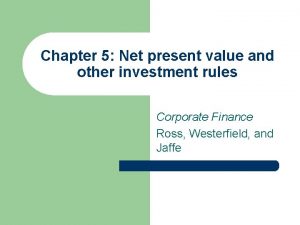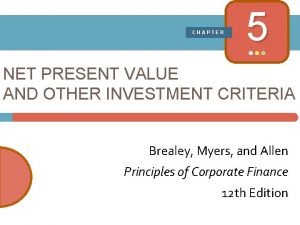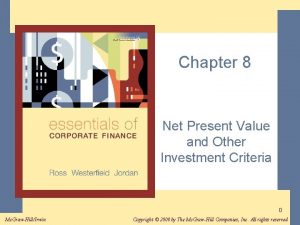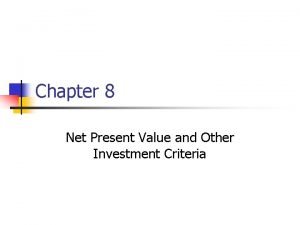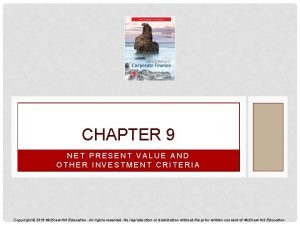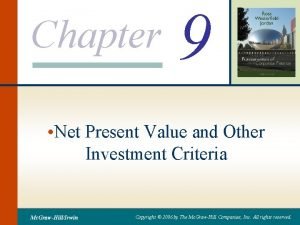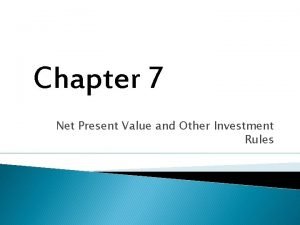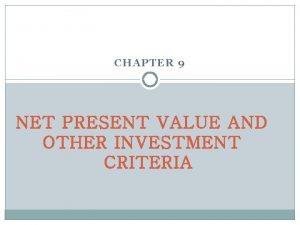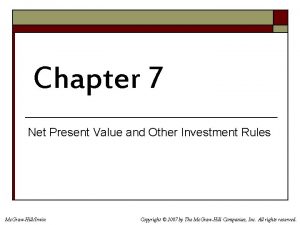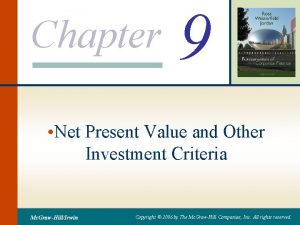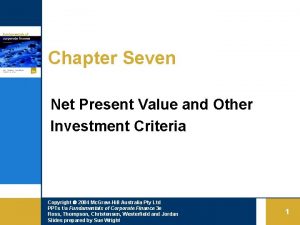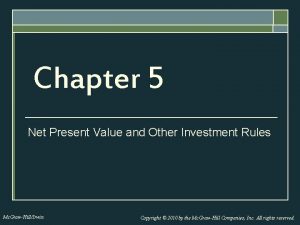Chapter 9 Net Present Value and Other Investment



















































































































- Slides: 115

Chapter 9 Net Present Value and Other Investment Criteria Copyright © 2012 by Mc. Graw-Hill Education. All rights reserved.

Key Concepts and Skills • Be able to compute payback and discounted payback and understand their shortcomings • Understand accounting rates of return and their shortcomings • Be able to compute internal rates of return (standard and modified) and understand their strengths and weaknesses • Be able to compute the net present value and understand why it is the best decision criterion • Be able to compute the profitability index and understand its relation to net present value 9 -2

Chapter Outline • • Capital Budgeting Overview Net Present Value The Payback Rule The Discounted Payback The Average Accounting Return The Internal Rate of Return The Profitability Index The Practice of Capital Budgeting 9 -3

Capital Budgeting Introduction - Objectives Identify and analyze prospective proposals, then decide which one(s) is expected to serve the goal of the firm, which is to maximize wealth of shareholders by maximizing the firm value. The selected project is then considered in the firm's capital budget (budget CF 0 and CFi) so that an appropriate financing is planned and arranged.

Importance of Capital Budgeting § Improve the firm’s value § Increase operating until MR=MCC § Survive competition by planning ahead of time § Plan financing needs and seek the appropriate financing sources at the appropriate (i. e. cheapest) cost.

Nature of Investment Proposals 1. Replacement: maintain current business 2. Replacement: Reduce current costs of production 3. Expansion of existing product(s) or market(s) 4. Growth: expansion to new product(s) or market(s) 5. Increase safety and/or environment projects to comply with government regulation, labor agreements or insurance policy 6. Others

Comparing Types of Investment Proposals 1. Mutually Exclusive Proposals: proposed projects serve same purpose - choose one and eliminate others - choose the one that maximizes the firm value the most. Example: You can choose to attend graduate school at either Harvard or Stanford, but not both 2. Independent Projects: projects, serve various purposes. The firm may undertake any combination or all independent projects depending on capital rationing (limited financial sources), if any, and on whether MR > MCC. 3. Contingent Projects: projects that can be executed in more than one combination of proposals.

Capital Budgeting Decision Rules Assumptions: 1) Cash flows are known with certainty. Cash flows are adjusted for tax, depreciation, salvage value effect and changes in NWC 2) All reviewed projects have same level of risk, and therefore their CFs are discounted at the same riskadjusted discount rate (RADR); otherwise they will be discounted at different risk-adjusted discount rates 3) All cash flows occur at the end of the year (i. e. , not evenly spread over the year)

Capital Budgeting Decision Rules We need to consider the following factors when evaluating capital budgeting decision rules: 1) Should consider all cash flows over the life of the project 2) Should consider time value of money (i. e. , short -term inflows are preferred to long-term inflows) where cash flows are discounted at the appropriate market opportunity cost (i. e. , at the cost of capital) 3) Should adjust for cash flows risk

Capital Budgeting Decision Rules 4) Choose the mutually exclusive (or independent) project(s) that would maximize the firm value 5) The method would allow managers to consider each project independently. A project with positive NPV adds to the value of the firm (i. e. , consistent with the value additivity principle) 6) The decision rule should provide information on whether we are creating value for the firm There are Eight Major Capital Budgeting Methods.

Net Present Value (NPV) Method Concept: • NPV is the difference between the market value of a project and its cost • How much value is created from undertaking an investment? • We discount expected cash flows to present and compare them to cash outflows paid now. An acceptable project should earn enough to cover its expected cash outflows considering time value of money

Net Present Value - Present value of cash flows minus initial investments. Opportunity Cost of Capital - Expected rate of return given up by investing in a project

Net Present Value (NPV) Method Procedure Ø find the PV of all cash inflows Ø find the PV of all cash outflows Ø add these PV →NPV = PV(cash inflows)-PV(cash outflows) OR Note: CFo, t = Cash outflows paid for investment only

Net Present Value NPV = PV - required investment

Net Present Value Terminology CF = Cash Flow t = time period of the investment r = “opportunity cost of capital” • The Cash Flow could be positive or negative at any time period.

Net Present Value Rule Managers increase shareholders’ wealth by accepting all projects that are worth more than they cost. Therefore, they should accept all projects with a positive net present value.

NPV – Decision Rule • If the NPV is positive, accept the project. A positive NPV, i. e. PV(CFi) > PV(CFo), means that the project is expected to add value to the firm and will therefore increase the wealth of the owners. • Since our goal is to increase owner wealth, NPV is a direct measure of how well this project will meet our goal. • If both projects are mutually exclusive, i. e. only one project to be selected, we would select the project with the highest NPV, otherwise we take all projects with ranked positive NPV. • Some firms take 0 NPV because the project is needed for the firm. 9 -17

Net Present Value Example Q: Suppose we can invest $50 today & receive $60 later today. What is our increase in value? A: Profit = - $50 + $60 = $10 $50 Added Value Initial Investment

Net Present Value Example Suppose we can invest $50 today and receive $60 in one year. What is our increase in value given a 10% expected return? $4. 55 $50 This is the definition of NPV Added Value Initial Investment

Net Present Value Example You have the opportunity to purchase an office building. You have a tenant lined up that will generate $16, 000 per year in cash flows for three years. At the end of three years you anticipate selling the building for $450, 000. How much would you be willing to pay for the building? R=7%.

Net Present Value Example - continued $466, 000 $450, 000 $16, 000 Present Value 14, 953 13, 975 380, 395 $409, 323 0 1 $16, 000 2 $16, 000 3

Net Present Value Example - continued If the building is being offered for sale at a price of $350, 000, would you buy the building and what is the added value generated by your purchase & management of the building? R=7%.

Net Present Value Example - continued If the building is being offered for sale at a price of $350, 000, would you buy the building and what is the added value generated by your purchase and management of the building?

Project Example Information • You are reviewing a new project and have estimated the following cash flows: – Year 0: CF = -165, 000 – Year 1: CF = 63, 120; NI = 13, 620 – Year 2: CF = 70, 800; NI = 3, 300 – Year 3: CF = 91, 080; NI = 29, 100 – Average Book Value = 72, 000 • Your required return for assets of this risk level is 12%. 9 -24

Computing NPV for the Project • Using the formulas: – NPV = -165, 000 + 63, 120/(1. 12) + 70, 800/(1. 12)2 + 91, 080/(1. 12)3 = 12, 627. 41 • Using the calculator: – CF 0 = -165, 000; C 01 = 63, 120; F 01 = 1; C 02 = 70, 800; F 02 = 1; C 03 = 91, 080; F 03 = 1; NPV; I = 12; CPT NPV = 12, 627. 41 • Do we accept or reject the project? 9 -25

Calculating NPVs with a Spreadsheet • Spreadsheets are an excellent way to compute NPVs, especially when you have to compute the cash flows as well. • Using the NPV function – The first component is the required return entered as a decimal – The second component is the range of cash flows beginning with year 1 – Subtract the initial investment after computing the NPV 9 -26

Project Interactions When you need to choose between mutually exclusive projects, the decision rule is simple. Calculate the NPV of each project, and, from those options that have a positive NPV, choose the one whose NPV is highest.

Mutually Exclusive Projects Example Select one of the two following projects, based on highest NPV. assume 7% discount rate

Net Present Value (NPV) Method Advantages: Ø It conforms with all guidelines of good capital budgeting method Ø Should NPV methods be the primary decision rule? Ø This method is not used always especially considering its superiority over other methods.

Payback Period • How long does it take to get the initial cost back in a nominal sense? • Computation – Estimate the cash flows – Subtract the future cash flows from the initial cost until the initial investment has been recovered If NCF is constant, then pay back period PB = I/NCF If NCF is constant and perpetual, then pay back period (PB) remains = I/NCF • Decision Rule – Accept if the payback period is less than some preset limit 9 -30

Computing Payback for the Project • Assume we will accept the project if it pays back within two years. – Year 1: 165, 000 – 63, 120 = 101, 880 still to recover – Year 2: 101, 880 – 70, 800 = 31, 080 still to recover – Year 3: 31, 080 – 91, 080 = -60, 000 project pays back in year 3 • Do we accept or reject the project? 9 -31

Decision Criteria Test - Payback • Does the payback rule account for the time value of money? • Does the payback rule account for the risk of the cash flows? • Does the payback rule provide an indication about the increase in value? • Should we consider the payback rule for our primary decision rule? 9 -32

Payback Method Example: discuss cases of outflows in more than one year. WHICH PROJECT TO CHOOSE?

Payback Method Solution: Cash Outflows = Cash Inflows = 0 For each project, you add cash outflows first then add cash inflows that offset the outflows, check the year the last cash inflow is expected → compute total # of years needed to recover original investment (including fraction of a year. )

Payback Method A: -1000 + 500 + 400 = -100 Year 3: inflow 300, needs only 100 → 100 ÷ 300 = ⅓ ▸ Answer: 2⅓ years to recover original investment B: -1000 + 100 + 300 +400 = -200 ▸ Answer: 3⅓ years to recover original investment Decision: Project A is preferable to B

Payback Method Example The three project below are available. The company accepts all projects with a 2 year or less payback period. Show this decision will impact our decision. Cash Flows C 2 C 3 Project C 0 C 1 NPV@10% A -2000 +10000 B -2000 +1000 0 C -2000 0 +2000 0 Payback 2 2 2 + 7, 249 264 347

Advantages of Payback • Advantages – Easy to understand – Simple & inexpensive to apply – Adjusts for uncertainty of later cash flows (so long recovery period implies higher risk) – Biased toward liquidity 9 -37

Disadvantages of Payback • Disadvantages – Ignores the time value of money. – Requires an arbitrary cutoff point. – Ignores cash flows beyond the cutoff date. These flows, if considered, may change the investment decision. – Biased against long-term projects, such as research and development, and new projects. – It does not tell whether the selected project maximizes the firm value. – Payback method may lead to incorrect capital investment decisions; however, it is widely used. 9 -38

Discounted Payback Period • Compute the present value of each cash flow and then determine how long it takes to pay back on a discounted basis • Compare to a specified required period • Decision Rule - Accept the project if it pays back on a discounted basis within the specified time 9 -39

Computing Discounted Payback for the Project • Assume we will accept the project if it pays back on a discounted basis in 2 years at 12%. • Compute the PV for each cash flow and determine the payback period using discounted cash flows – Year 1: 165, 000 – 63, 120/1. 121 = 108, 643 – Year 2: 108, 643 – 70, 800/1. 122 = 52, 202 – Year 3: 52, 202 – 91, 080/1. 123 = -12, 627 project pays back in year 3 • Do we accept or reject the project? 9 -40

Decision Criteria Test – Discounted Payback • Does the discounted payback rule account for the time value of money? • Does the discounted payback rule account for the risk of the cash flows? • Does the discounted payback rule provide an indication about the increase in value? • Should we consider the discounted payback rule for our primary decision rule? 9 -41

Advantages and Disadvantages of Discounted Payback • Advantages – Includes time value of money – Easy to understand – Does not accept negative estimated NPV investments when all future cash flows are positive – Biased towards liquidity • Disadvantages – May reject positive NPV investments – Requires an arbitrary cutoff point – Ignores cash flows beyond the cutoff point – Biased against long-term projects, such as R&D and new products 9 -42

Average Accounting Return • There are many different definitions for average accounting return • The one used in the book is: – Average net income / average book value – Note that the average book value depends on how the asset is depreciated. • Need to have a target cutoff rate • Decision Rule: Accept the project if the AAR is greater than a preset rate 9 -43

Average Accounting Return Method Return on Investment (ROI) Method or Average Accounting Return (AAR) choose the project that has the highest ratio of average expected net income to investment, i. e. the highest rate of return on investment Where: Io n = initial cash outlay = life of the project

Computing AAR for the Project • Assume we require an average accounting return of 25% • Average Net Income: – (13, 620 + 3, 300 + 29, 100) / 3 = 15, 340 • AAR = 15, 340 / 72, 000 =. 213 = 21. 3% • Do we accept or reject the project? 9 -45

Decision Criteria Test - AAR • Does the AAR rule account for the time value of money? • Does the AAR rule account for the risk of the cash flows? • Does the AAR rule provide an indication about the increase in value? • Should we consider the AAR rule for our primary decision rule? 9 -46

Advantages and Disadvantages of AAR • Advantages – Easy to calculate – Simple and inexpensive to use – Needed information will usually be available – Measures rate of return on the investment • Disadvantages – Not a true rate of return; time value of money is ignored – Uses an arbitrary benchmark cutoff rate – Based on accounting net income and book values, not cash flows and market values – It does not tell whether the selected project maximizes the firm value 9 -47

Internal Rate of Return (IRR) • This is the most important alternative to NPV • It is often used in practice and is intuitively appealing • It is based entirely on the estimated cash flows and is independent of interest rates found elsewhere 9 -48

IRR – Definition and Decision Rule • Definition: IRR is the return that makes the NPV = 0; i. e. , where PV(cash outflows) = PV (cash inflows) • This rate is the minimum rate of return (IRR) acceptable by management. Set NPV = and solve for IRR • Decision Rule: Accept the project if the IRR is greater than the required return. When comparing projects, choose the highest IRR. This rate must be ≥ cost of capital. 9 -49

Internal Rate of Return (IRR) Method Case 1: even cash inflows ► this case is a straightforward application of the discounted annuity cash flows technique. STEPS: 1) PV = E(CF)*PVIFAIRR, n → PVIFAIRR, n = PV ÷ E(CF) 2) Determine number of years, n 3) number of years (n) and * PVIFAIRR, n

Computing IRR for the Project • Case 2: uneven cash inflows • If you do not have a financial calculator, then this becomes a trial and error process • OR by Calculator – Enter the cash flows as you did with NPV – Press IRR and then CPT – IRR = 16. 13% > 12% required return • Do we accept or reject the project? • Alternative Solutions: – Graphical Solution – Spreadsheet 9 -51

NPV Profile for the Project IRR = 16. 13% 9 -52

Internal Rate of Return (IRR) Method Another Example:

IRR Trial and Error Approach: HOW TO DETERMINE r? Ø start by choosing an arbitrary r, plug it in the NPV equation and check equality Ø if the answer comes to be negative, then reduce the rate Ø if the answer is positive, then raise the discount rate Ø repeat until you reach the zero solution Solution: Let us try 10%

IRR Positive NPV► increase your r. A to 15% At 15% ∴ decrease r. A to 14% NPVA = -1000+(500 x. 8772)+(400 x. 7695)+(300 x. 6750)+(100. 5921)=8. 11>0 ∴ r. A = 14% is low, 15% is high ► it must be 14%< r. A <15% ►HINT: -8. 33 < 0 < 8. 11 ▸ r. A is in the middle between 14 & 15% ▸ r=IRRA =14. 5%

IRR For B: Notice that this NPVB is lower than NPVA ▸ so we should increase the discount rate from 10% a bit, but to less than 15% ∴ let us try 12% = -1000+(100 x. 8929)+(300 x. 7972)+(400 x. 7118)+(600 x. 638) =-1000+89. 29+234. 14+284. 72+381. 3 = -5. 53 < 0 Since -5. 53 is close to zero, then IRRB rate should be close but less than 12%: ▸ Choose Project A because IRRA = 14. 5% > IRRB = 11. 8% ▸ Doing trial & error is really not easy and is tedious and time consuming.

IRR Graphical Solution Project A: r =0% ► NPVA = 300 r =15% ► NPVA = -8. 33 Project B: r = 0% ▸ NPVB = 400 r = 12%▸ NPVB = -5. 53 IRRA<15% IRRB < 12%

IRR GOOD APPROXIMATION

IRR Problem Area!! How to determine the Cross-Over Point (COR)? The crossover rate (COR) is the rate at which the NPVs of both projects are equal. To find the exact value of COR, we should: 1. create a project Δ, which is the difference in cash flows between projects A and B. 2. Solve for the IRR. In this case, IRR is COR.

Internal Rate of Return Another Example You can purchase a building for $350, 000. The investment will generate $16, 000 in cash flows (i. e. rent) during the first three years. At the end of three years you will sell the building for $450, 000. What is the IRR on this investment? IRR = 12. 96%

Internal Rate of Return

Internal Rate of Return IRR=12. 96%

Internal Rate of Return Calculating the IRR can be a laborious task. Fortunately, financial calculators can perform this function easily. Note the previous example. HP-10 B EL-733 A -350, 000 CFj -350, 000 CFi 16, 000 CFj Work}16, 000 -350, 000 ENTER 466, 000 CFj {IRR/YR} BAII Plus CFj 466, 000 CFi IRR CF 16, 000 CFfi 2 nd 16, 000 ENTER 466, 000 ENTER IRR All produce IRR=12. 96 CPT {CLR CFi

Internal Rate of Return Another Example You have two proposals to choose between. The initial proposal (H) has a cash flow that is different than the revised proposal (I). Using IRR, which do you prefer?

Internal Rate of Return

Internal Rate of Return NPV $, 1, 000 s 50 40 Revised proposal 30 IRR= 12. 96% 20 10 IRR= 14. 29% Initial proposal 0 -10 IRR= 12. 26% -20 8 10 12 Discount rate, % 14 16

NPV vs. IRR • NPV directly measures the increase in value to the firm. NPV and IRR will generally give us the same decision • Exceptions – Nonconventional cash flows – cash flow signs change more than once – Mutually exclusive projects • Initial investments are substantially different (issue of scale) • Timing of cash flows is substantially different 9 -67

IRR and Nonconventional Cash Flows • When the cash flows change sign more than once, there is more than one IRR • When you solve for IRR you are solving for the root of an equation, and when you cross the xaxis more than once, there will be more than one return that solves the equation • If you have more than one IRR, which one do you use to make your decision? 9 -68

Another Example – Nonconventional Cash Flows • Suppose an investment will cost $90, 000 initially and will generate the following cash flows: – Year 1: 132, 000 – Year 2: 100, 000 – Year 3: -150, 000 • The required return is 15%. • Should we accept or reject the project? 9 -69

NPV Profile IRR = 10. 11% and 42. 66% 9 -70

Decision Rules • The NPV is positive at a required return of 15%, so you should Accept • If you use the financial calculator, you would get an IRR of 10. 11% which would tell you to Reject. An IRR of 42% would tell you to Accept • You need to recognize that there are nonconventional cash flows and look at the NPV profile • Whenever there is a conflict between NPV and another decision rule, you should always use NPV 9 -71

IRR and Mutually Exclusive Projects • Mutually exclusive projects: Intuitively, you would use the following decision rules: – NPV – choose the project with the higher NPV – IRR – choose the project with the higher IRR 9 -72

Example With Mutually Exclusive Projects Period Project A Project B 0 -500 -400 1 325 200 IRR 19. 43% 22. 17% NPV 64. 05 60. 74 The required return for both projects is 10%. Which project should you accept and why? 9 -73

NPV Profiles IRR for A = 19. 43% IRR for B = 22. 17% Crossover Point = 11. 8% 9 -74

Calculating IRRs With A Spreadsheet • You start with the cash flows the same as you did for the NPV • You use the IRR function – You first enter your range of cash flows, beginning with the initial cash flow – You can enter a guess, but it is not necessary – The default format is a whole percent – you will normally want to increase the decimal places to at least two 9 -75

Decision Criteria Test - IRR • Does the IRR rule account for the time value of money? • Does the IRR rule account for the risk of the cash flows? • Does the IRR rule provide an indication about the increase in value? • Should we consider the IRR rule for our primary decision criteria? 9 -76

Advantages of IRR • Knowing a return is intuitively appealing • It is a simple way to communicate the value of a project to someone who doesn’t know all the estimation details • If the IRR is high enough, you may not need to estimate a required return, which is often a difficult task 9 -77

Internal Rate of Return Pitfall 1 - Mutually Exclusive Projects Ü IRR sometimes ignores the magnitude of the project. Pitfall 2 - Lending or Borrowing? • With some cash flows (as noted below) the NPV of the project increases s the discount rate increases. • This is contrary to the normal relationship between NPV and discount rates. Pitfall 3 - Multiple Rates of Return Ü Certain cash flows can generate NPV=0 at two different discount rates.

Modified IRR (MIRR) • The basic idea is to modify cash flows first, then calculate an IRR using these modified cash flows. • Pros: – MIRR eliminates the multiple IRR problem (pitfall # 3). – Managers like rate of return comparisons, and MIRR is better for this than IRR. • There are three methods: The Discounting Approach, The Reinvestment Approach, and The Combination Approach. 9 -79

Modified IRR* (MIRR) • The Discounting Approach: – Discount all negative cash flows back to the present at the required rate of return (i. e. , WACC), and add them to the initial cost. – Calculate IRR*. • The Reinvestment Approach: – MIRR is the discount rate that causes the PV of a project’s terminal value (TV) to equal the PV of costs. – Compute the future value (TV) of all positive and negative cash flows, except the initial cost, compounded until the end (as if we reinvesting them) at the required rate of return. – Calculate IRR* that equates the PV of all reinvested CF with the initial cost. 9 -80

Modified IRR* (MIRR) • The Combination Approach: – Discount all negative cash outflows back to the present at the borrowing rate, and add them to the initial cost. – Compound all positive cash flows to the end of the project at the required rate of return (i. e. , reinvesting rate) – Calculate IRR* that equates these values. – Benefits: single answer and specific rates for borrowing and reinvestment 9 -81

MIRR Using the Reinvestment Approach: First, Find PV and TV (r = 10%) 0 10% -100. 0 1 2 3 10. 0 60. 0 80. 0 10% -100. 0 PV outflows 66. 0 12. 1 158. 1 TV inflows 82

Second, Find Discount Rate that Equates PV and TV 0 -100. 0 1 2 MIRR = 16. 5% PV outflows 3 158. 1 TV inflows $100 = $158. 1 (1+MIRRL)3 MIRRL = 16. 5% 83

To find TV with Calculator 12 B: Step 1, Find PV of Inflows • First, enter cash inflows in CFLO register: CF 0 = 0, CF 1 = 10, CF 2 = 60, CF 3 = 80 • Second, enter I/YR = 10. • Third, find PV of inflows: Press NPV = 118. 78 84

Step 2, Find TV of Inflows • Enter PV = -118. 78, N = 3, I/YR = 10, PMT = 0. • Press FV = 158. 10 = FV of inflows. 85

Step 3, Find PV of Outflows • For this problem, there is only one outflow, CF 0 = -100, so the PV of outflows is -100. • For other problems there may be negative cash flows for several years, and you must find the present value for all negative cash flows. 86

Step 4, Find “IRR” of TV of Inflows and PV of Outflows • Enter FV = 158. 10, PV = -100, PMT = 0, N = 3. • Press I/YR = 16. 50% = MIRR. 87

Profitability Index Method Profitability Index (PI) Method (also called PV Index or Benefit/Cost Ratio). PI measures the benefit per unit cost, based on the time value of money. Steps - choose the project that has the highest expected profitability - Model: PI is the PV of the future cash flows divided by the initial investment.

Profitability Index (PI) • A profitability index of 1. 1 implies that for every $1 of investment, we create an additional $0. 10 in value • Decision rule: if PI > 1 → accept project if PI < 1 → reject project • This measure can be very useful in situations in which we have limited capital (i. e. , capital rationing) • Pros: useful when investment funds are limited • Cons: when original CF are different, PI may lead to incorrect ranking compared to NPV 9 -89

PI Example: PV of Future Cash Flows Project L: 0 9. 09 49. 59 60. 11 118. 79 10% 1 2 3 10 60 80 90

Profitability Index Example PIL = PV future CF Initial cost = $118. 79 $100 PIL = 1. 1879 PIS = 1. 1998 91

Profitability Index

Advantages and Disadvantages of Profitability Index • Advantages – Closely related to NPV, generally leading to identical decisions – Easy to understand communicate – May be useful when available investment funds are limited • Disadvantages – it is not meaningful (not rate, not dollar return) → just meaningless index – When cash outflows occur in later years of the project, the PI method may rank projects significantly different from the standard NPV method. Hence, PI may lead to incorrect decisions in comparisons of mutually exclusive investments 9 -93

? ? Equivalent Annual Annuity (EAA) (or Equivalent Annual Cost, EAC) - The cash flow period with the same present value as the cost of buying and operating a machine. NPV∞ =EAA/r

? ? Equivalent Annual Annuity Example Given the following costs of operating two machines and a 6% cost of capital, select the lower cost machine using equivalent annual annuity method. Mach. F G Year 1 2 -15 -4 -10 -6 3 -4 -6 4 -4 PV@6% E. A. A. -25. 69 - 9. 61 -21. 00 -11. 45

? ? Equivalent Annual Annuity Example (with a twist) Select one of the two following projects, based on highest “equivalent annual annuity” (r=9%). 2. 82 2. 78 . 87 1. 10

Summary – DCF Criteria • Net present value – Difference between market value and cost – Take the project if the NPV is positive – Has no serious problems – Preferred decision criterion • Internal rate of return – Discount rate that makes NPV = 0 – Take the project if the IRR is greater than the required return – Same decision as NPV with conventional cash flows – IRR is unreliable with nonconventional cash flows or mutually exclusive projects 9 -97

Summary – DCF Criteria • Profitability Index – Benefit-cost ratio – Take investment if PI > 1 – Cannot be used to rank mutually exclusive projects – May be used to rank projects in the presence of capital rationing • Payback period – Length of time until initial investment is recovered – Take the project if it pays back within some specified period – Doesn’t account for time value of money, and there is an arbitrary cutoff period 9 -98

Summary – Payback Criteria • Discounted payback period – Length of time until initial investment is recovered on a discounted basis – Take the project if it pays back in some specified period – There is an arbitrary cutoff period • Average Accounting Return – Measure of accounting profit relative to book value – Similar to return on assets measure – Take the investment if the AAR exceeds some specified return level – Serious problems and should not be used 9 -99

Capital Budgeting In Practice • We should consider several investment criteria when making decisions • NPV and IRR are the most commonly used primary investment criteria • Payback is a commonly used secondary investment criteria 9 -100

Capital Budgeting Techniques

Quick Quiz • Consider an investment that costs $100, 000 and has a cash inflow of $25, 000 every year for 5 years. The required return is 9%, and required payback is 4 years. – What is the payback period? – What is the discounted payback period? – What is the NPV? – What is the IRR? – Should we accept the project? • What decision rule should be the primary decision method? • When is the IRR rule unreliable? 9 -102

Quick Quiz • Payback period = 4 years • The project does not pay back on a discounted basis. • NPV = -2, 758. 72 • IRR = 7. 93% 9 -103

Comprehensive Problem • An investment project has the following cash flows: CF 0 = -1, 000; C 01 – C 08 = 200, 000 each • If the required rate of return is 12%, what decision should be made using NPV? • How would the IRR decision rule be used for this project, and what decision would be reached? • How are the above two decisions related? 9 -104

Comprehensive Problem - Solution • NPV = -$6, 472; reject the project since it would lower the value of the firm. • IRR = 11. 81%, so reject the project since it would tie up investable funds in a project that will provide insufficient return (less than the required 12%). • The NPV and IRR decision rules will provide the same decision for all independent projects with conventional/normal cash flow patterns. • If a project adds value to the firm (i. e. , has a positive NPV), then it must be expected to provide a return above that which is required. Both of those justifications are good for shareholders. 9 -105

Ethics Issues • An ABC poll in the spring of 2004 found that one-third of students age 12 – 17 admitted to cheating and the percentage increased as the students got older and felt more grade pressure. If a book entitled “How to Cheat: A User’s Guide” would generate a positive NPV, would it be proper for a publishing company to offer the new book? • Assume the publishing company has a cost of capital of 8% and estimates it could sell 10, 000 volumes by the end of year one and 5, 000 volumes in each of the following two years. The immediate printing costs for the 20, 000 volumes would be $20, 000. The book would sell for $7. 50 per copy and net the company a profit of $6 per copy after royalties, marketing costs and taxes. Year one net would be $60, 000. From a capital budgeting standpoint, is it financially wise to buy the publication rights? What is the NPV of this investment? 9 -106

Ethics Issues Answers • The year 0 cash flow is -20, 000, year 1 is 60, 000, and years 2 and 3 are 30, 000 each. Given a cost of capital of 8%, the NPV is just over $85, 000. It looks good, right? • if the publishing of this book would encourage cheating, would the publishing company want to be associated with this text and its message. This type of issue is not uncommon and serves as a starting point for a discussion of the value of “reputational capital. ” 9 -107

Ethics Issues • Should a firm exceed the minimum legal limits of government imposed environmental regulations and be responsible for the environment, even if this responsibility leads to a wealth reduction for the firm? Is environmental damage merely a cost of doing business? 9 -108

Ethics Issues Answers • Assume that to comply with the Air Quality Control Act of 1989, a company must install 3 smoke stack scrubber units to its ventilation stacks at an installed cost of $355, 000 per unit. An estimated $100, 000 per unit in fines could be saved each year over the five-year life of the ventilation stacks. The cost of capital is 14% for the firm. • The analysis of the investment results in a NPV of $35, 076. • Could investment in a healthier working environment result in lower long-term costs in the form of lower future health costs? • If so, might this decision result in an increase in shareholder wealth? 9 -109

Ethics Issues • Should municipalities offer monetary incentives to induce firms to relocate to their areas? 9 -110

? ? Investment Timing Decision Sometimes you have the ability to defer an investment and select a time that is more ideal at which to make the investment decision. A common example involves a tree farm. You may defer the harvesting of trees. By doing so, you defer the receipt of the cash flow, yet increase the cash flow.

? ? Investment Timing Example You may purchase a computer anytime within the next five years. While the computer will save your company money, the cost of computers continues to decline. If your cost of capital is 10% and given the data listed below, when should you purchase the computer?

? ? Investment Timing Solution: Year 0 1 2 3 4 5 Cost 50 45 40 36 33 31 PV Savings 70 70 70 NPV at Purchase NPV Today 20 20. 0 25 22. 7 30 24. 8 34 Date to purchase 25. 5 37 25. 3 39 24. 2

? ? Capital Rationing - Limit set on the amount of funds available for investment. Soft Rationing - Limits on available funds imposed by management. Hard Rationing - Limits on available funds imposed by the unavailability of funds in the capital market.

End of Chapter 9 -115
 Advantages and disadvantages of payback method
Advantages and disadvantages of payback method Chapter 9 net present value and other investment criteria
Chapter 9 net present value and other investment criteria Advantage and disadvantage of npv
Advantage and disadvantage of npv Chapter 9 net present value and other investment criteria
Chapter 9 net present value and other investment criteria Net present value of investment
Net present value of investment Fixed investment and inventory investment
Fixed investment and inventory investment Contoh value creation adalah
Contoh value creation adalah Bcr formula
Bcr formula Npv meaning
Npv meaning Npv meaning
Npv meaning Net present value practice problems
Net present value practice problems Pva factor
Pva factor Npv meaning
Npv meaning Analisis kriteria investasi
Analisis kriteria investasi Present value vs future value
Present value vs future value Present simple present continuous and present perfect
Present simple present continuous and present perfect Value line investment survey
Value line investment survey Types of position
Types of position I write a letter now past continuous tense
I write a letter now past continuous tense Difference between present perfect simple and continuous
Difference between present perfect simple and continuous Present perfect present simple present continuous
Present perfect present simple present continuous Relative clause noredink
Relative clause noredink Present perfect simple and continuous
Present perfect simple and continuous Present simple present continuous present perfect
Present simple present continuous present perfect Firm based trade theory
Firm based trade theory Mankiw chapter 26 solutions
Mankiw chapter 26 solutions Value received and value parted with
Value received and value parted with T test p value interpretation
T test p value interpretation D value and z value
D value and z value Saponification number
Saponification number Creating and capturing value
Creating and capturing value Present simple vs present continuous
Present simple vs present continuous Achmed lach net
Achmed lach net Ado.net vb.net
Ado.net vb.net Chapter 1 the investment environment
Chapter 1 the investment environment Intermediate accounting chapter 17
Intermediate accounting chapter 17 Pv of cca tax shield formula
Pv of cca tax shield formula Chapter 8 foreign direct investment
Chapter 8 foreign direct investment Chapter 10 making capital investment decisions
Chapter 10 making capital investment decisions Chapter 1 the investment environment
Chapter 1 the investment environment The value net framework
The value net framework Net realizable value
Net realizable value Useful life of property plant and equipment
Useful life of property plant and equipment Retail inventory method
Retail inventory method Ias 2 net realisable value
Ias 2 net realisable value Relative value vs absolute value
Relative value vs absolute value How to find expected value of a spinner
How to find expected value of a spinner What is the value of what is the value of
What is the value of what is the value of Fulya batur
Fulya batur Present and future value of money
Present and future value of money Stylistic continuum in interlanguage
Stylistic continuum in interlanguage Interlanguage and social identity and investment
Interlanguage and social identity and investment Alcohol is the most commonly used drug in our society
Alcohol is the most commonly used drug in our society Chapter 31 schizophrenia and other psychoses
Chapter 31 schizophrenia and other psychoses Chapter 15 alcohol other drugs and driving
Chapter 15 alcohol other drugs and driving Chapter 15 alcohol other drugs and driving
Chapter 15 alcohol other drugs and driving Inverse functions
Inverse functions Chapter 11 real estate and other investments
Chapter 11 real estate and other investments Levered free cash flow formula
Levered free cash flow formula Future value of deferred annuity
Future value of deferred annuity Future worth analysis adalah
Future worth analysis adalah Present value of perpetuity
Present value of perpetuity Annuity growth
Annuity growth Growing annuity formula
Growing annuity formula Finance grade 12
Finance grade 12 Present value factor
Present value factor Pvgo
Pvgo Present value of annuity
Present value of annuity Annuities definition
Annuities definition Tabel present value
Tabel present value Tabel present value
Tabel present value Yield to maturity formula
Yield to maturity formula Present value of $1
Present value of $1 Actuarial present value
Actuarial present value Pengertian nilai sekarang
Pengertian nilai sekarang Pv factor table
Pv factor table Rumus pv interest
Rumus pv interest Fv of ordinary annuity table
Fv of ordinary annuity table Present progressive用法
Present progressive用法 Simple present present progressive
Simple present present progressive Present simple present continuous forms
Present simple present continuous forms Present simple or present continuous
Present simple or present continuous Jeopardy past continuous
Jeopardy past continuous Perfect vs progressive
Perfect vs progressive Timetable present simple
Timetable present simple Passive voice in present perfect continuous
Passive voice in present perfect continuous Future perfect continuous passive voice
Future perfect continuous passive voice Grammar quiz present continuous
Grammar quiz present continuous Simple present or present progressive
Simple present or present progressive Carry present continuous
Carry present continuous Time expression present perfect continuous
Time expression present perfect continuous Present perfect auxiliary
Present perfect auxiliary Present simple tense present continuous
Present simple tense present continuous Bike present continuous
Bike present continuous Present simple and present progressive
Present simple and present progressive Present simpl
Present simpl Present perfet
Present perfet Present continuous ing
Present continuous ing Unit 1 present simple
Unit 1 present simple Present continuous and present simple 1
Present continuous and present simple 1 Present simple и present continuous правила
Present simple и present continuous правила Present simple and present continuous
Present simple and present continuous Indicative vs subjunctive spanish conjugations
Indicative vs subjunctive spanish conjugations Present simple form
Present simple form Key words tenses
Key words tenses Foreign direct investment advantages and disadvantages
Foreign direct investment advantages and disadvantages Sadc protocol on finance and investment
Sadc protocol on finance and investment Immuno oncology bd&l and investment forum
Immuno oncology bd&l and investment forum Fdi definition
Fdi definition Investment banking functions
Investment banking functions Collaborative strategies in international business
Collaborative strategies in international business Foreign direct investment advantages and disadvantages
Foreign direct investment advantages and disadvantages Financing and investing cycle
Financing and investing cycle Apex brasil miami
Apex brasil miami Export marketing and investment assistance
Export marketing and investment assistance Cisi introduction to securities and investment
Cisi introduction to securities and investment
